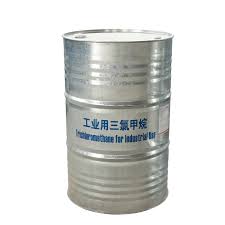Is Trichloromethane Polar?
A Simple Chemistry Breakdown
Trichloromethane, also known as chloroform, is a simple chemical compound made up of carbon, hydrogen, and chlorine atoms. It’s widely recognised for its role in various scientific and industrial applications, from solvents to anaesthetics. But when it comes to understanding its molecular behaviour, a key question arises: is it polar or non-polar? Polarity influences how molecules interact with each other, affecting their solubility, reactivity, and even how they behave in different environments. In this post, we’ll break down the structure of trichloromethane and explain how its polarity—or lack of it—affects its properties.
Understanding Trichloromethane
Trichloromethane, commonly referred to as chloroform, is a fascinating chemical compound with diverse applications. Its unique structure and properties have made it an essential substance both in scientific research and industrial processes. Let’s look more closely at what trichloromethane is, how its molecular structure forms, and the ways it’s used in everyday life and specialised fields.

What is Trichloromethane?
Trichloromethane, more widely known as chloroform, is an organic compound with the chemical formula CHCl₃. It’s composed of one carbon atom, one hydrogen atom, and three chlorine atoms. This colourless liquid has a slightly sweet odour and is categorised as a volatile substance because it evaporates easily at room temperature.
Chloroform has earned its place as a widely used industrial and laboratory solvent due to its ability to dissolve a range of compounds. For decades, it has been indispensable in fields like organic chemistry, where it plays a key role in producing other chemical substances. You can learn more about its properties on Wikipedia’s Chloroform page.
Molecular Structure of Trichloromethane
The molecular geometry of trichloromethane is straightforward yet important in understanding its behaviour. The central carbon atom is bonded to three chlorine atoms and one hydrogen atom, which are arranged in a tetrahedral structure. The hydrogen and chlorine atoms are situated around the carbon in a way that causes the molecule to exhibit slight polar characteristics, which we’ll explore further later in this article.
In simpler terms, imagine trichloromethane as a three-pronged claw where the carbon atom forms the ‘palm’, and the hydrogen and chlorines are the ‘fingers’. Each bond between the carbon and the other atoms is a single covalent bond. More details about its structure can be found on PubChem.
Common Applications of Trichloromethane
Trichloromethane features prominently in a variety of applications, thanks to its solvent properties and chemical reactivity:
- Medical Use: Historically, chloroform was used as an anaesthetic during surgeries. Although it’s no longer common in modern medicine due to safety concerns, its legacy is significant.
- Chemical Synthesis: It serves as an intermediate in creating other compounds, including pesticides, dyes, and refrigerants.
- Industrial Uses: In many industries, it’s employed as a solvent in organic chemistry reactions and even in the production of certain pharmaceuticals. It also appears in products like adhesives and cleaning agents.
You can find further examples of its uses on the Wisconsin Department of Health Services website.
From its structure to its uses, trichloromethane remains an essential compound with a wide array of applications spanning both historical significance and modern industrial relevance. Each of these factors contributes to its importance, which will become even clearer as we explore its polar nature in the sections to follow.
What is Molecular Polarity?
Molecular polarity plays a key role in determining how a molecule behaves and interacts with its environment. Whether you’re a student, researcher, or just someone curious about chemistry, understanding this concept is essential for exploring molecular interactions, solubility, and other properties. Let’s break it down step by step.
Definition of Molecular Polarity
In simple terms, molecular polarity refers to how electric charge is distributed within a molecule. Some molecules have areas of positive and negative charge due to the unequal sharing of electrons between atoms. This leads to the formation of dipole moments—the measure of the molecule’s polarity.
The unequal electron sharing often arises because of electronegativity differences between atoms. Electronegativity describes an atom’s ability to attract electrons in a bond. For example, in a bond between hydrogen and chlorine, chlorine has a much higher electronegativity. This causes a partial negative charge on chlorine and a partial positive charge on hydrogen.
When these polarity differences exist within a molecule, it can create an overall molecular dipole, impacting how the molecule interacts with others. You can explore a more in-depth explanation on Chem LibreTexts about Molecular Polarity.
Factors Influencing Polarity
Several factors determine whether a molecule will be polar or non-polar. Below are the main ones you should know:
- Molecular Geometry: The shape of a molecule significantly impacts its polarity. For instance, even if a molecule has polar bonds, its shape might cause these dipoles to cancel out. A good example is carbon dioxide (CO₂), which, despite having polar bonds, is non-polar due to its linear structure. Learn how shape impacts polarity on Wyzant’s discussion on molecular polarity.
- Bond Polarity: The polarity of individual bonds within a molecule depends on the electronegativity difference between the bonded atoms. Larger electronegativity differences result in more polar bonds.
- Electron Distribution: Within a molecule, how electrons are spread out across atoms determines its dipole moment. Uneven distribution, like in water (H₂O), results in a polar molecule. However, molecules like methane (CH₄) exhibit a symmetric distribution, making them non-polar.
To determine a molecule’s overall polarity, chemists consider the sum and direction of its bond dipoles. If the dipoles align in the same direction, the molecule is polar. If they cancel out due to symmetry, the molecule is non-polar. You can find additional details about these factors at Britannica’s Molecular Polarity overview.
Each of these factors contributes to either pulling electrons unequally or balancing them out. By examining these, you can predict whether a molecule, like trichloromethane, will have polar or non-polar characteristics.






